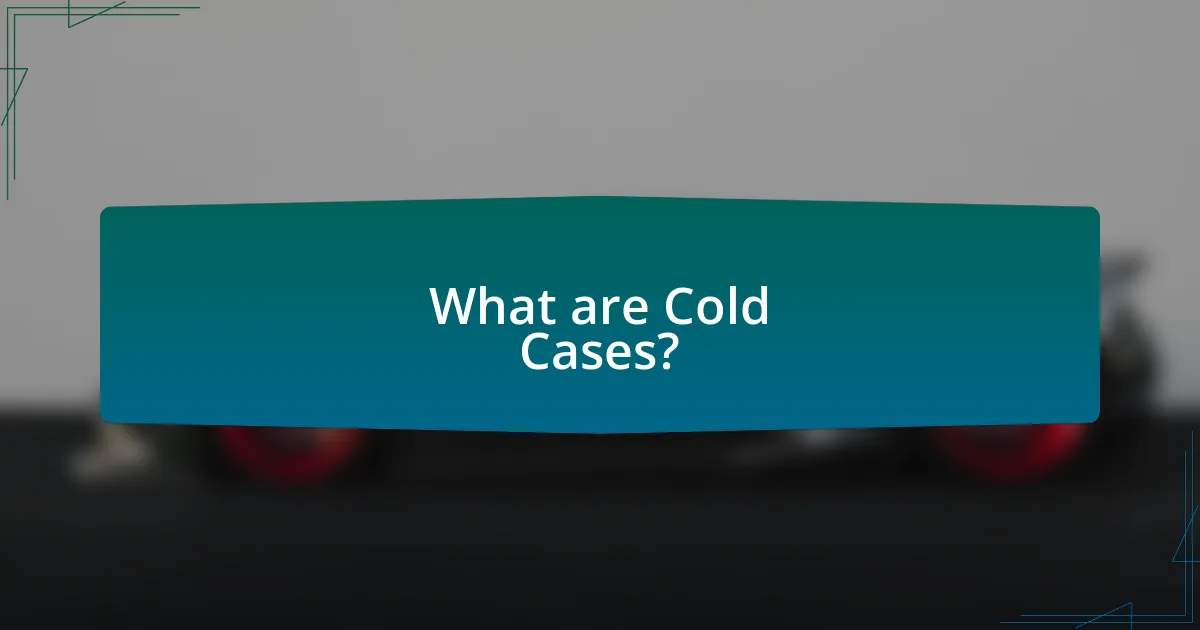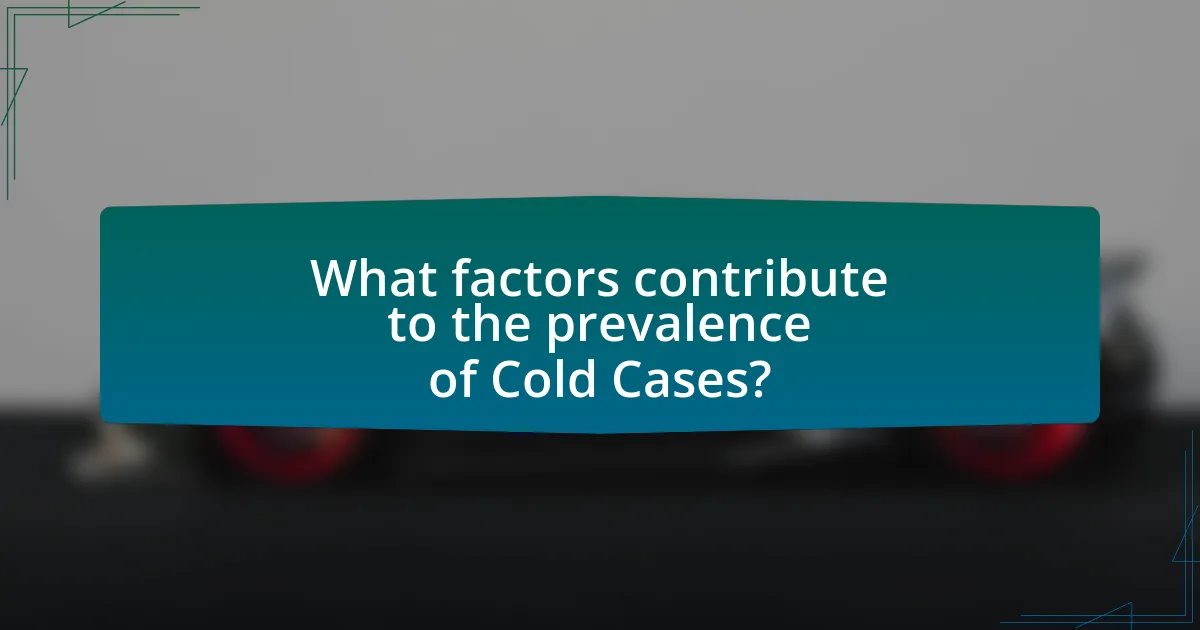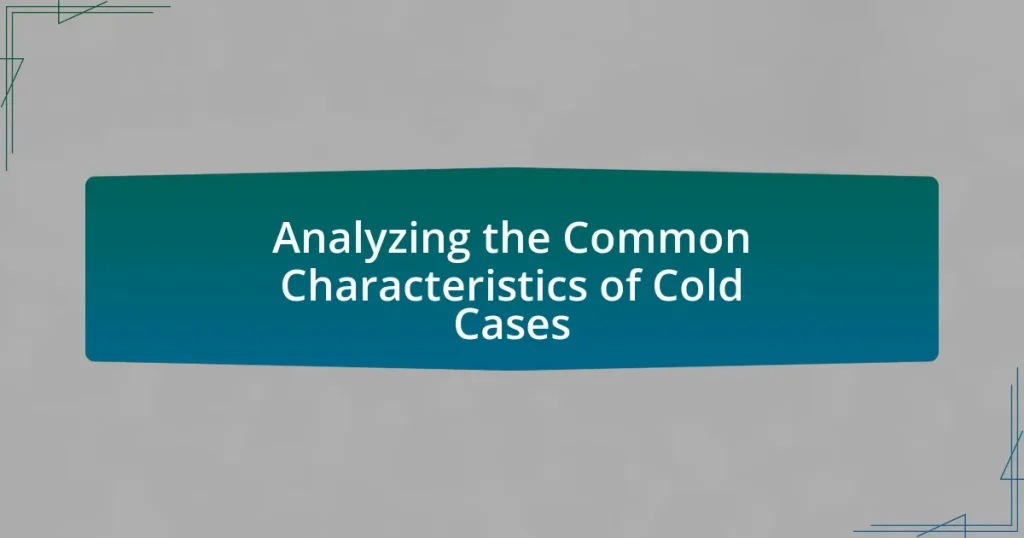Cold cases are criminal investigations that remain unsolved for an extended period, typically due to insufficient evidence or leads. This article analyzes the common characteristics of cold cases, including their definition within the criminal justice system, the criteria for classification, and the factors contributing to their prevalence. It explores the challenges faced by law enforcement in solving these cases, the role of technology and public interest, and the psychological impact on victims’ families. Additionally, it discusses best practices for investigating cold cases and the importance of collaboration between agencies to enhance resolution outcomes.

What are Cold Cases?
Cold cases are criminal investigations that remain unsolved after a significant period, typically due to a lack of evidence or leads. These cases often involve serious crimes such as homicides or disappearances, where law enforcement has exhausted all available investigative avenues. According to the FBI, a case is considered cold when it has not been actively pursued for a certain duration, often defined as several years, and no new evidence has emerged to warrant reopening the investigation.
How are Cold Cases defined in the criminal justice system?
Cold cases in the criminal justice system are defined as unsolved criminal investigations that have not been active for a significant period, typically several years, due to a lack of evidence or leads. These cases remain open but are often deprioritized, as law enforcement agencies focus on more recent crimes. According to the FBI, cold cases can include homicides, missing persons, and sexual assaults, where new evidence or advancements in forensic technology may eventually lead to resolution.
What criteria classify a case as a Cold Case?
A case is classified as a Cold Case when it remains unsolved for an extended period, typically defined as three years or more, and lacks new leads or evidence. Cold Cases often involve homicides, missing persons, or serious crimes where investigative efforts have stalled, and law enforcement agencies have exhausted all available resources. According to the FBI, approximately 6,000 homicides in the United States remain unsolved each year, highlighting the prevalence of Cold Cases.
Why do some cases remain unsolved for extended periods?
Some cases remain unsolved for extended periods due to a combination of insufficient evidence, lack of witnesses, and investigative challenges. Insufficient evidence can stem from the absence of physical or forensic clues that are crucial for solving a case. For example, in many homicide cases, the lack of a body or weapon can hinder progress. Additionally, a lack of witnesses or unwillingness of potential witnesses to come forward can leave investigators without leads. Investigative challenges, such as limited resources or changes in law enforcement personnel, can also contribute to prolonged unsolved cases. According to the FBI, approximately 40% of homicides in the United States remain unsolved, highlighting the complexities involved in criminal investigations.
What are the common characteristics of Cold Cases?
Cold cases typically exhibit several common characteristics, including a lack of new leads, unresolved evidence, and prolonged periods without resolution. These cases often involve unsolved homicides or missing persons where investigative efforts have stalled, leading to their classification as “cold.” For instance, according to the FBI, cold cases can remain open for years or even decades, with many relying on advancements in forensic technology or renewed public interest to generate new leads. Additionally, cold cases frequently involve complex circumstances, such as limited witness cooperation or insufficient physical evidence at the time of the original investigation.
How do the circumstances of Cold Cases differ from active cases?
Cold cases differ from active cases primarily in their status and the level of investigative resources allocated. Active cases are currently being investigated, with ongoing leads and potential suspects, while cold cases have remained unsolved for an extended period, often due to a lack of evidence or leads. For instance, according to the FBI, cold cases can remain open for years or even decades, with law enforcement agencies often revisiting them only when new evidence emerges or when resources allow. This distinction highlights the urgency and focus present in active cases compared to the stagnation typically associated with cold cases.
What role does evidence play in the classification of Cold Cases?
Evidence is crucial in the classification of cold cases as it determines the viability of reopening investigations. In cold cases, evidence such as DNA, fingerprints, and witness statements can provide new leads or confirm existing theories. For instance, advancements in forensic technology have allowed previously untestable evidence to be analyzed, leading to the resolution of cases that had remained unsolved for decades. This demonstrates that the quality and type of evidence directly influence whether a case is classified as cold and the potential for it to be reclassified as active.
Why is it important to analyze Cold Cases?
Analyzing cold cases is important because it can lead to the resolution of unresolved crimes, providing closure to victims’ families and potentially bringing justice. Cold cases often contain overlooked evidence or new forensic technologies that can yield fresh insights. For instance, advancements in DNA analysis have solved cases that were previously deemed unsolvable, as seen in the exoneration of individuals wrongfully convicted based on outdated methods. Furthermore, reviewing cold cases can help identify patterns in criminal behavior, aiding law enforcement in preventing future crimes.
How can analyzing Cold Cases contribute to solving them?
Analyzing cold cases can significantly contribute to solving them by uncovering overlooked evidence and identifying new leads. Investigators can re-examine physical evidence with advanced forensic techniques, such as DNA analysis, which may not have been available at the time of the original investigation. For instance, the use of familial DNA has led to breakthroughs in cases that had remained unsolved for decades. Additionally, reviewing witness statements and case files can reveal inconsistencies or new perspectives that may prompt fresh inquiries. Historical data shows that approximately 10% of cold cases are solved upon re-examination, highlighting the potential effectiveness of this approach.
What insights can be gained from studying the patterns in Cold Cases?
Studying the patterns in Cold Cases reveals critical insights into criminal behavior, investigative techniques, and potential leads for resolution. Analyzing these cases often uncovers common characteristics such as victimology, modus operandi, and geographical patterns, which can inform current investigations. For instance, research indicates that approximately 70% of Cold Cases involve similar demographic profiles of victims, suggesting that understanding these patterns can help law enforcement prioritize cases and allocate resources effectively. Additionally, examining the timeline of events in Cold Cases can highlight gaps in evidence collection or investigative methods, leading to improved strategies in solving ongoing cases.

What factors contribute to the prevalence of Cold Cases?
The prevalence of cold cases is primarily influenced by factors such as insufficient evidence, lack of witnesses, and resource limitations within law enforcement agencies. Insufficient evidence often leads to cases being unsolvable at the time of investigation, resulting in them being classified as cold. Additionally, a lack of witnesses can hinder the collection of crucial information, making it difficult to progress in the investigation. Resource limitations, including budget constraints and personnel shortages, can further impede the ability of law enforcement to dedicate time and effort to unresolved cases. According to the FBI, approximately 6,000 homicides remain unsolved each year in the United States, highlighting the significant impact of these factors on the prevalence of cold cases.
How do investigative resources impact the number of Cold Cases?
Investigative resources significantly reduce the number of cold cases by enhancing the capacity to solve previously unsolved crimes. When law enforcement agencies allocate more personnel, technology, and funding to investigations, they increase the likelihood of gathering new evidence or re-examining existing evidence, which can lead to breakthroughs in cases that have remained unresolved for years. For instance, the introduction of advanced forensic techniques, such as DNA analysis, has been shown to solve cold cases that were once deemed unsolvable, as evidenced by the success of initiatives like the FBI’s Cold Case Initiative, which has led to the resolution of numerous cases through improved investigative methods and resources.
What challenges do law enforcement agencies face in solving Cold Cases?
Law enforcement agencies face several challenges in solving cold cases, primarily due to limited evidence and resources. Cold cases often involve outdated forensic technology, which can hinder the analysis of physical evidence. Additionally, the passage of time can lead to the loss of crucial witness testimony, as potential witnesses may have moved, forgotten details, or passed away.
Moreover, law enforcement agencies frequently deal with budget constraints that limit their ability to dedicate personnel and resources to cold case investigations. According to the FBI, there are over 250,000 unsolved homicides in the United States, highlighting the overwhelming number of cases that can divert attention from cold cases.
Furthermore, the emotional toll on families of victims can complicate investigations, as they may have differing expectations regarding the resolution of the case. These factors collectively contribute to the difficulties law enforcement faces in effectively solving cold cases.
How does public interest influence the investigation of Cold Cases?
Public interest significantly influences the investigation of cold cases by increasing pressure on law enforcement agencies to allocate resources and prioritize these unsolved crimes. When the public shows heightened interest, often through media coverage or community advocacy, it can lead to renewed investigations, as seen in cases like the Golden State Killer, where public tips and DNA advancements were spurred by widespread media attention. Additionally, public interest can result in funding opportunities for investigative efforts, as seen in initiatives like the National Institute of Justice’s Cold Case Review Program, which provides grants specifically for cold case investigations. This demonstrates that active public engagement can directly impact the resources and attention dedicated to solving cold cases.
What role does technology play in the resolution of Cold Cases?
Technology plays a crucial role in the resolution of cold cases by providing advanced tools for evidence analysis and data management. For instance, forensic DNA analysis has significantly improved, allowing law enforcement to re-examine old evidence with modern techniques that can yield new leads. Additionally, digital databases enable the cross-referencing of information across jurisdictions, increasing the chances of identifying suspects or linking cases. The use of artificial intelligence in pattern recognition helps investigators uncover connections that may have been overlooked. These technological advancements have led to the reopening and successful resolution of numerous cold cases, demonstrating their effectiveness in modern criminal investigations.
How have advancements in forensic science affected Cold Case investigations?
Advancements in forensic science have significantly enhanced the effectiveness of Cold Case investigations by providing new tools and techniques for evidence analysis. For instance, the development of DNA profiling has allowed investigators to re-examine old evidence, leading to the identification of suspects in cases that were previously unsolvable. According to a study published in the Journal of Forensic Sciences, the application of modern DNA techniques has resulted in a 20% increase in the resolution of Cold Cases over the past decade. Additionally, advancements in digital forensics, such as improved data recovery methods and the analysis of electronic devices, have opened new avenues for gathering evidence that was not available during the original investigation. These innovations have not only helped solve existing cases but have also contributed to the exoneration of wrongfully convicted individuals, thereby underscoring the transformative impact of forensic science on Cold Case investigations.
What technological tools are most effective in reopening Cold Cases?
DNA analysis tools, particularly advanced techniques like Next Generation Sequencing (NGS) and mitochondrial DNA testing, are the most effective technological tools in reopening cold cases. These methods allow forensic scientists to extract and analyze DNA from old evidence, even when samples are degraded or limited. For instance, NGS can provide comprehensive genetic profiles that were previously unattainable, leading to new leads and potential suspects. Additionally, forensic databases, such as CODIS (Combined DNA Index System), enable law enforcement to match DNA profiles from cold cases with those of known offenders, significantly increasing the chances of solving these cases.

What are the psychological aspects of Cold Cases?
The psychological aspects of cold cases primarily involve the emotional impact on victims’ families, the psychological toll on investigators, and the cognitive biases that can affect case resolution. Families of victims often experience prolonged grief, frustration, and a sense of helplessness due to the unresolved nature of the case, which can lead to mental health issues such as depression and anxiety. Investigators may face burnout and emotional fatigue from working on cases that yield no results, which can hinder their effectiveness. Additionally, cognitive biases, such as confirmation bias, can impede the investigation process, as investigators may focus on evidence that supports their initial theories while overlooking contradictory information. These psychological factors contribute significantly to the complexities surrounding cold cases and their resolution.
How do Cold Cases affect the families of victims?
Cold cases significantly impact the families of victims by prolonging their grief and preventing closure. Families often experience ongoing emotional distress, as unresolved cases can lead to feelings of helplessness and frustration. According to a study published in the Journal of Criminal Justice, families of homicide victims reported higher levels of anxiety and depression when cases remained unsolved, highlighting the psychological toll of cold cases. This lack of resolution can hinder the healing process, as families may continuously seek answers and justice, which remains elusive in cold cases.
What emotional challenges do families face when dealing with Cold Cases?
Families dealing with cold cases face significant emotional challenges, including prolonged grief, uncertainty, and frustration. The unresolved nature of cold cases often leads to a lack of closure, which can exacerbate feelings of loss and helplessness. Research indicates that families may experience heightened anxiety and depression due to the ongoing search for answers, as well as the stigma associated with unresolved crimes. Additionally, the emotional toll can manifest in strained relationships among family members, as differing coping mechanisms and levels of hope can create tension. These challenges are compounded by the societal perception of cold cases, which can lead to feelings of isolation for families who feel their loved ones are forgotten.
How can support systems help families of Cold Case victims?
Support systems can help families of Cold Case victims by providing emotional, psychological, and practical assistance during their prolonged search for justice. These systems often include support groups, counseling services, and community resources that foster a sense of belonging and understanding among families facing similar challenges. Research indicates that families who engage with support systems report lower levels of anxiety and depression, as they receive validation and shared experiences from others who understand their grief and frustration. Additionally, these support networks can facilitate access to legal resources and advocacy, enhancing the families’ ability to navigate the complexities of the criminal justice system.
What motivates detectives to pursue Cold Cases?
Detectives are motivated to pursue cold cases primarily by the desire for justice and closure for victims and their families. This motivation is driven by a commitment to uphold the law and resolve unresolved crimes, which can often lead to new evidence or leads that were previously overlooked. According to the FBI, cold cases can be reopened when new technology, such as DNA analysis, becomes available, allowing detectives to revisit evidence and potentially solve cases that have remained stagnant for years. Additionally, the emotional impact of unsolved cases on communities and the personal drive of detectives to bring resolution further fuels their pursuit of these challenging investigations.
How does personal dedication influence the investigation of Cold Cases?
Personal dedication significantly enhances the investigation of cold cases by ensuring sustained focus and commitment from investigators. This dedication often leads to thorough reviews of evidence, re-interviews of witnesses, and the exploration of new leads that may have been overlooked initially. For instance, dedicated detectives have been known to revisit cold cases years later, utilizing advancements in forensic technology, such as DNA analysis, which can yield new insights and potentially solve cases that had remained unresolved for decades. The case of the Golden State Killer exemplifies this, where a dedicated team utilized genetic genealogy to identify the suspect after decades of investigation. Such dedication not only drives the investigative process but also fosters collaboration among law enforcement agencies, increasing the likelihood of solving cold cases.
What are the ethical considerations in pursuing Cold Cases?
The ethical considerations in pursuing cold cases include the potential for re-traumatizing victims’ families, the accuracy of evidence handling, and the implications of reopening investigations on public trust. Re-engaging with families can evoke painful memories, necessitating sensitivity and clear communication from investigators. Furthermore, the integrity of evidence must be maintained to avoid wrongful accusations or misinterpretations, as seen in cases where mishandled evidence led to wrongful convictions. Lastly, transparency in the investigative process is crucial to uphold public trust, as communities may feel skepticism if they perceive that cases are being pursued without adequate justification or resources.
What best practices can be applied to Cold Case investigations?
Best practices for Cold Case investigations include thorough case reviews, re-examination of evidence, and utilizing modern forensic technologies. Conducting a comprehensive review allows investigators to identify overlooked details and inconsistencies in the original investigation. Re-examining physical evidence, such as DNA or fingerprints, with advanced techniques can yield new leads. Additionally, engaging with the community for fresh tips and insights can provide new perspectives. These practices are supported by the success of various law enforcement agencies that have solved cold cases through similar methods, demonstrating their effectiveness in revitalizing stalled investigations.
How can collaboration between agencies improve Cold Case outcomes?
Collaboration between agencies can significantly improve cold case outcomes by pooling resources, expertise, and information. When multiple law enforcement agencies work together, they can share critical evidence, leverage specialized skills, and access broader databases, which increases the likelihood of uncovering new leads. For instance, the FBI’s Violent Criminal Apprehension Program (ViCAP) facilitates inter-agency collaboration by allowing law enforcement to share information about violent crimes, leading to connections that may not be evident within a single jurisdiction. This collaborative approach has been shown to enhance investigative strategies and ultimately solve cases that have remained unresolved for years.
What strategies can detectives use to maintain momentum in Cold Cases?
Detectives can maintain momentum in cold cases by employing strategies such as regular case reviews, leveraging new technology, and engaging with the community. Regular case reviews allow detectives to reassess evidence and witness statements, which can lead to new insights or leads. For instance, the use of DNA technology has solved numerous cold cases by re-examining old evidence with modern techniques, as seen in the case of the Golden State Killer, where advancements in genetic genealogy played a crucial role. Additionally, community engagement through outreach programs can encourage new witnesses to come forward, providing fresh information that can reignite investigations. These strategies collectively enhance the likelihood of solving cold cases by ensuring that they remain active and relevant.


